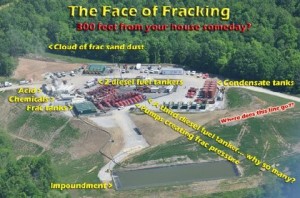Fracking companies use loopholes to avoid permits for dangerous chemicals
From an Article by Laura Arenschield, Columbus Dispatch, October 23, 2014
Federal laws meant to protect drinking water require fracking companies to get a permit before using diesel fuel in the drilling process. That permit is important: Diesel fuel contains chemicals that can cause cancer and damage nerve tissues. The permits regulate the length and depth of concrete and steel well casings that keep those chemicals from reaching groundwater.
But a loophole in the law allows oil and gas companies to separately inject the same toxic chemicals without a permit, according to a report released by the nonprofit, nonpartisan Environmental Integrity Project.
Four chemicals in diesel — benzene, toluene, ethylbenzene and xylene — are the biggest worries to federal regulators and environmental and health officials. Benzene is a known carcinogen. Ethylbenzene and toluene can cause neurological problems.
The Safe Water Drinking Act requires extensive oversight if diesel is used during drilling or fracking, in part because of its benzene content. Diesel can be used, for example, as a lubricant for a pipe or drill going into the ground. Yet all those chemicals are allowed to be used during fracking without a permit issued under the Safe Water Drinking Act, the Environmental Integrity Project said.
The report shows that at least six fracking-fluid additives contain more benzene than diesel fuel, and that at least 21 contain higher concentrations of ethylbenzene, xylene or toluene than diesel.
“From a health and safety perspective, it obviously makes no sense to be restricting diesel because of concerns about its benzene content, (and not) to be doing that for products that have so much more benzene in them,” said Eric Schaeffer, executive director of the Environmental Integrity Project. “While hydro-fracking offers obvious economic benefits, that does come at an environmental cost we are just beginning to understand.”
Natural-gas production in Ohio increased by 97 percent from 2012 to 2013, according to the most recent data available from the Ohio Department of Natural Resources, the agency that regulates drilling. As of the end of June, Ohio had issued permits for more than 1,400 wells that have been or will be fracked.
For the report, the Environmental Integrity Project reviewed data on the FracFocus Chemical Disclosure Registry, a website sponsored by the oil and gas industry that collects information about the chemicals used in drilling and fracking.
Last month, a study published in the Proceedings of the National Academy of Sciences reported that while fracking does not inherently contaminate nearby drinking water with methane, poorly constructed wells with leaky casings or faulty concrete can allow the gas to leach into drinking water.
Researchers from Ohio State, Duke, Stanford and Dartmouth universities and the University of Rochester analyzed 133 samples from drinking-water wells over the Marcellus and Barnett shale formations. Barnett shale is found mostly in Texas. The researchers found eight clusters of methane-contaminated groundwater wells near shale-drilling sites — seven in the Marcellus region and one in the Barnett.
The U.S. Environmental Protection Agency announced in February that it would start researching federal and state governments’ ability to manage potential threats to water resources from hydraulic fracturing. That report is not yet finished.
Brian Kunkemoeller, a conservation project manager with the Sierra Club’s Ohio chapter, said that the Environmental Integrity Project report shows that laws need to be tightened. “Until these major loopholes are reversed, there are not enough protections on the books for clean water,” he said.

